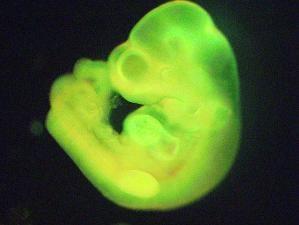January 29, 2014
In experiments that could open a new era in stem cell biology, scientists have found a cheap and easy way to reprogramme mature cells from mice back into an embryonic-like state that allowed them to generate many types of tissue.

January 29, 2014
In experiments that could open a new era in stem cell biology, scientists have found a cheap and easy way to reprogramme mature cells from mice back into an embryonic-like state that allowed them to generate many types of tissue.

This undated image made available by the journal Nature shows a mouse embryo formed with specially-treated cells from a newborn mouse that had been transformed into stem cells. Researchers in Boston and Japan say they created stem cells from various tissues of newborn mice.
The research, described as game changer by experts in the field, suggests human cells could in future be reprogrammed by the same technique, offering a simpler way to replace damaged cells or grow new organs for sick and injured people.
Chris Mason, chair of regenerative medicine bioprocessing at University College London, who was not involved in the work, said its approach was "the most simple, lowest-cost and quickest method" to generate so-called pluripotent cells — able to develop into many different cell types — from mature cells.
"If it works in man, this could be the game changer that ultimately makes a wide range of cell therapies available using the patient's own cells as starting material — the age of personalized medicine would have finally arrived," he said.
The experiments, reported in two papers in the journal Nature on Wednesday, involved scientists from the RIKEN Center for Developmental Biology in Japan and Brigham and Women's Hospital and Harvard Medical School in the United States.
Beginning with mature, adult cells, researchers let them multiply and then subjected them to stress "almost to the point of death", they explained, by exposing them to various events including trauma, low oxygen levels and acidic environments.
Within days, the scientists found that the cells survived and recovered from the stressful stimulus by naturally reverting into a state similar to that of an embryonic stem cell.
These stem cells created by this exposure to stresses — dubbed STAP cells by the researchers — were then able to differentiate and mature into different types of cells and tissue, depending on the environments they were given.
"If we can work out the mechanisms by which differentiation states are maintained and lost, it could open up a wide range of possibilities for new research and applications using living cells," said Haruko Obokata, who lead the work at RIKEN.
Stem cells are the body's master cells and are able to differentiate into all other types of cells. Scientists say that, by helping to regenerate tissue, they could offer ways of tackling diseases for which there are currently only limited treatments – including heart disease, Parkinson's and stroke.
There are two main types of stem cells: embryonic ones, harvested from embryos, and adult or iPS cells, which are taken from skin or blood and reprogrammed back into stem cells.
Because the harvesting of embryonic stem cells requires the destruction of a human embryo, the technique has been the subject of ethical concerns and protests from pro-life campaigners.
Dusko Ilic, a reader in stem cell science at Kings College London, said the Nature studies described "a major scientific discovery" and predicted their findings would open "a new era in stem cell biology".
"Whether human cells would respond in a similar way to comparable environmental cues … remains to be shown," he said in an emailed comment. "I am sure that the group is working on this and I would not be surprised if they succeed even within this calendar year."
Courtesy: Reuters
















































































































